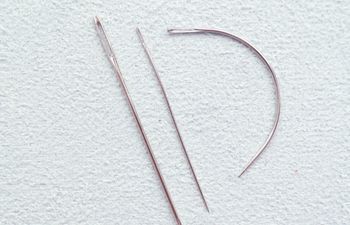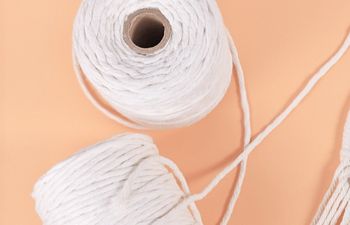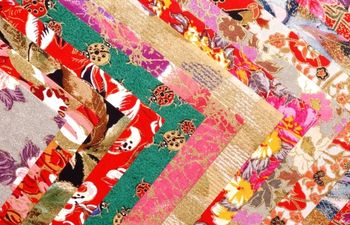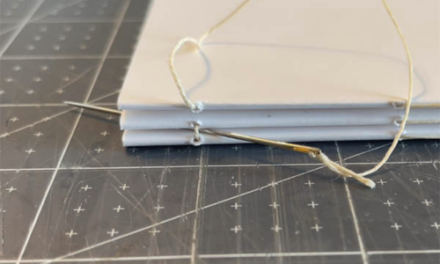Bookbinding needles are an important tool in any binder’s kit, but getting started with the right one can be difficult when there is so much (often conflicting) information out there. In this post, I’ll cover some bookbinding needle basics and walk you through the three things I consider before choosing a needle for my project.
First, what is a bookbinding needle?
A bookbinding needle is a tool used by a book binder to sew the sections or signatures of a book together. There are no strict requirements for a needle, which is why this topic can be somewhat confusing to research online.
Needles from many crafts have found their way into bookbinding over the years, so you’ll often hear terms like these thrown around:
- Darning
- Darner’s
- Hook eye
- Large eye
- Blunt tip
- Bookbinder’s needle
- and many more
While all these different words and names can be confusing, there are two things they each have in common: a long shaft and large eye.
In bookbinding, we tend to prefer longer needles with a larger eye because they’re easier to handle and thread. Needles with a blunt tip are even better, in my opinion, because they’re less likely to jab you. At the end of the day, the preference is yours.
Why is a bookbinding needle so important?
There are many reasons, but here are my top three:
- Every sewn text block requires a needle, so it’s basically required
- A comfortable needle can increase sewing speed & efficiency
- Good needles can actually help control spine swell
3 things to consider before choosing a bookbinding needle
Before I pick up a needle, I always consider the following three things:
- Shape – what needle shape would work best for this binding type?
- Length – am I working on a small or large book, thick or thin paper?
- Gauge – how thick does my needle need to be to fit my chosen thread?
Bookbinding needle shape
Straight vs. curved bookbinding needles
In book binding, we use straight and curved needles. Some book makers will use one type for all projects, while others (like me) tend to switch based on the binding method (such as curved needles for Coptics).
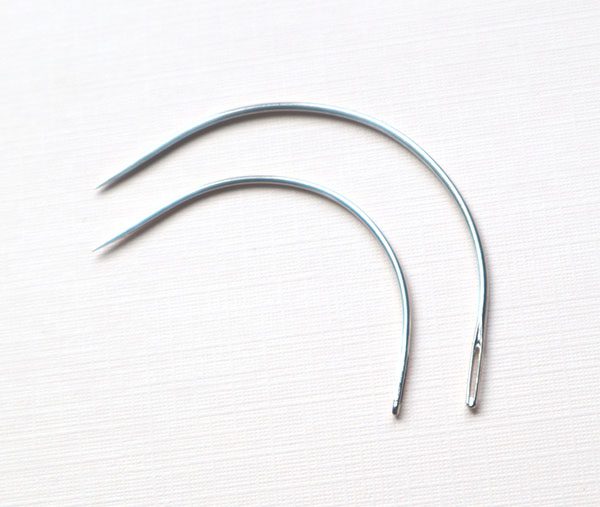
Believe it or not, needle shape makes a big difference when sewing certain types of bindings. It’s not technical, but more like whether or not the needle feels awkward in your hand while stitching.
When I started bookbinding, I always used a straight needle. It felt like the “right” thing to do. The more I tried different types of bindings, the more I noticed the needle didn’t flow as smoothly. I got pretty frustrated and even poked my finger a few times. After a while, I found I liked straight needles for certain bindings and curved for others.
Since we all have different sized hands and dexterity, there’s no right or wrong way to pick a needle shape. Just try them both and see what you like best.
Does needle size matter?
There are two factors to consider when discussing book binding needle size:
- length (long vs. short)
- gauge (thick vs. thin)
Gauge is a measurement of the thickness of a needle. Sizes are numerical and differ between the USA and Europe. C.S Osborne and John James are two needle makers I prefer to buy from. You can see needle gauge sizes here on a handy C.S. Osborne Needle Gauge Chart. Very thin needles are harder to manage, so most bookbinders work with 15 gauge or higher.
Bookbinding needle length
Needle length is usually measured in inches or cm.
Using a long or short needle is a preference, but there are practical reasons for both. Longer needles (2 inches (5cm) or greater) tend to be easier to handle. Shorter needles could get “lost” in the board and paper, which is just annoying.
If you’re struggling to manage a short needle while sewing, try moving up a 1/2″ (1.25cm) at a time until you find a good length. In bookbinding, I see a lot of 1-3/4″ and 2-1/2″ (measured from end to end) long needles.
Here are a few of my own:
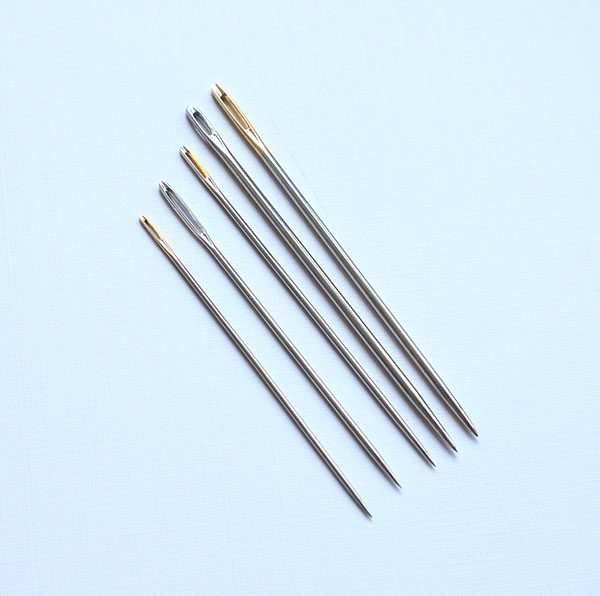
Bookbinding needle gauge
Needle thickness (gauge) can make your sewing holes bigger by accident, which can let more glue in. I talk about spine swell when picking thread size, but needle thickness is in the same camp. Needle thickness measures the diameter of the needle and is expressed as a number (#1, #3, etc.). The most common thicknesses used in bookbinding are #11, #15, #18 and #20.
Choose a needle thickness that fits the pierced hole as closely as possible (not too hard to move through and not too easy either).
Extra info to consider
Needle point, eye size and shape are a few additional properties you might want to consider when making your selection. Here is a bit of information on each.
Needle eye size & shape
The “eye” of a needle is just the opening at the top where the thread is looped and tied. Bookbinding needles usually have pretty big eyes so we can use thicker threads.
There are two bookbinding needle eye shapes you’ll see a lot: oval (egg) and circle. Each usually has a polished eye to reduce wear on thread.
Oval eye needle shapes are the most common. Some manufacturers produce an eye shape that falls between an oval and a circle. These are sometimes called “egg shaped.”
Sharp and blunt bookbinding needles
Fun fact: a true “bookbinder’s needle” is actually blunt or has a rounded tip. Crazy, eh? Truth is, we don’t need sharp needles for books because we pre-pierce the paper with an awl before sewing starts.
Sharp needles are just fine to use, but use care. I’ve stabbed myself too many times to mention! In fact, these days I tend to prefer rounded and blunt tip needles because they’re less likely to attack me.
Where to find bookbinding needles
- Darner’s & Bookbinder’s Needles – Colophon Book Arts
- Curved Needles – Talas Online and Colophon Book Arts
More bookbinding goodness
✨ What tools do I need to get started bookbinding?
- Bookbinding Tools & Supplies Quick Start Guide – learn all about book making tools, which to buy first & where to go online
- Pick up my popular Complete Starter Bookbinding Tools Kit – all the bookbinding essentials in one spot
🌟 Looking for a simple way to start making books?
Try a Complete Book Materials Kit. Each one has everything you need (+ tutorials & videos) to make a beautiful book without all the fuss.
Thank you for taking me along on your book making journey!
Misty
